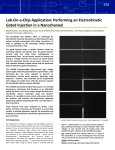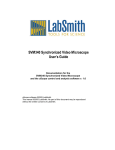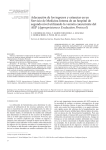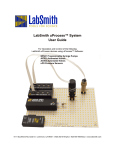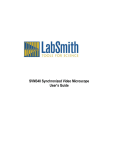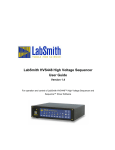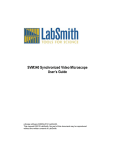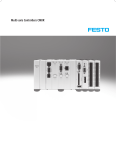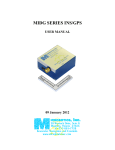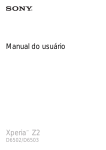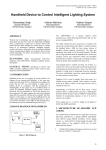Download - LabSmith
Transcript
Lab-on-a-Chip Application: Field Amplified Sample Stacking (FASS) for Sample Concentration in a Nanochannel Elizaveta Davies, Lesa Bishop, Adam Lucio, Jackson Travis del Bonis-O’Donnell, Sumita Pennathur, University of California, Santa Barbara; Yolanda Fintschenko, LabSmith, Inc. A ubiquitous problem in analytical chemistry is the push to increase signal-to-noise (S/N) and to lower the limits of detection (LOD) for many sample separation methods. Low S/N is typically due to the inherent low concentration of the sample in the system and the band-broadening of the sample in dead volumes of the analytical system. The microfluidic chip platform can address both these issues. Microfluidic channel networks have an advantage over conventional fluidics for chemical separations by eliminating dead volume found in tubing-based connections. This can be exploited when using electric field manipulation for increasing the concentration of sample in the injected volume. Field Amplified Sample Stacking (FASS) takes advantage of the effect of applying an electric field across a conductivity gradient in the buffer. The amplification gained by FASS is even more efficient when coupled with a microfluidic chip, due to channel integration that minimizes dead volumes. In this application note, we will describe the procedure for FASS using commerical LabSmith equipment. Introduction Field-amplified sample stacking, or FASS, first described in the late 1 1970s for traditional capillary electrophoresis applications , has 2 been optimized in the 1990s through the present for applications from traditional capillary zone electrophoresis to nanofluidic 3 separations . The stacking effect in a fluid-filled channel is caused by an electric field gradient created when the background electrolyte in the sample is lower in conductivity than the buffer, as shown in Figure 1. The charged sample of interest is at least three orders of magnitude lower than the electrolyte, so the fluid’s electrical conductivity is determined solely by the electrolyte in the sample. When an electric field is applied across the channel, it has a step change increase within the low conductivity region due to increased resistance. This results in a higher electrophoretic velocity of the sample ions within the low conductivity region relative to the high conductivity buffer. Therefore, the sample ions quickly leave the low conductivity region and slow upon reaching the high conductivity region. This causes the sample to occupy less volume as it is accelerated into this boundary, increasing concentration in a narrow band. The term “stacking” refers to the finite increase in sample ion concentration across the interface between different conductivities. Figure 1. FASS Principle Schematic. Top: No stacking. Conductivity in regions A, B and C are equivalent. The electric field is the same across all regions of the channel. Bottom: FASS. Conductivity is A =C>>B. The electric field is greater in sample region B. Sample stacking occurs where the electrophoretic velocity (UEPHORETIC) increases dramatically at the region of the border between A and B, but the electroosmotic flow (EOF) is still stronger and drags everything, including the concentrated sample plug (yellow), to the cathode. Figure 1 shows this schematically for a negatively charged sample ion. This concentration factor can be controlled and preserved using a microfluidic chip. The experiment described below is a classic tool that has useful applications and teaches students and new microfluidics practitioners about the effect of electric fields, controlling the injection step to preserve stacking by minimizing dilution due to dead volume, and the effects of these conditions on the subsequent separation. Coupled with a gated-injection, this experiment is a powerful illustration of electrophoretic, electrokinetic, and microfluidic principles. Control of electric fields, timing, and inverted fluorescent microscopy and data recording is required for FASS to succeed. The HVS448 programmable eight-channel high voltage power supply controls eight ports which can be used for up to two simultaneous on-chip FASS experiments. The SVM340 Synchronized Video Microscope is an inverted fluorescence microscope that is used to image the injection itself and provide raw data for the measurement of the downstream separated sample plug. The HVS448 Sequence™ software gives the user fully-automated control of the electric field program applied to each electrode. These features have been employed by Davies, Lucio, Bishop, Del Bonis O-Donnell, and Pennathur at University of California, Santa Barbara, to successfully produce a teaching laboratory exercise, training students to perform and analyze the results of FASS on a chemical separation. GOAL: The novice will learn how to create an electric field gradient to control sample stacking by varying buffer conditions, electric field strengths, and injection times. Users can use either a gated or 4 pinched injection to load the sample. For operating guidelines with LabSmith equipment, refer to the gated injection or pinched 5,6 injection application notes to optimize their injection conditions. High-Voltage Power Supply (HVS448) Setup 1. 2. FASS Experimental Set-Up Equipment and Materials LabSmith SVM340 Synchronized Video Microscope with uScope™ software o SVM340 Black and White Camera Module o Blue Illuminator o 10X DIN 0.25 objective o 515 nm Long-pass filter LabSmith HVS448 6000D High Voltage Sequencer with Sequence™ software o Platinum electrodes (4) o Micro-Clip connectors o High Voltage Cables 10-100 µL pipette with 100 µL pipette tips 0.2 µm solution filter Particle-free wipes Disposable nitrile gloves Safety goggles Glass cross-channel nanochip (Figure 2) with 250 nm deep x 7.5 µm wide channels ( Dolomite chip, http://www.dolomitemicrofluidics.com/en/design/custom-devices ). Solutions Buffer: 10 mM Phosphate buffer at pH ~7.2 Fluorescent Sample: 1 mM Phosphate buffer (pH ~7.2) with 1 mM sodium fluorescein Deionized (DI) water (18 MΩ) 100 mM potassium hydroxide (KOH) 3. Plug HVS448 into wall power and to computer via the RS232 port. Turn on the unit and launch the Sequence™ software. Create a new Sequence file using the steps in Table 1 for Sequence Steps A-F. a. See the Using the Sequence Wizards to Create a Sequence File section of the Sequence Users Manual (pp 13-17) for instruction on making a Simple Sequence Wizard and Running a Sequence. Note: The values in Table 1 were developed for use with a specific chip geometry and buffer pH as described in the Experimental Set-Up section. You will need to adjust the voltages if using a different configuration. Connect the high-voltage cables to the HVS448: a. Turn off the HVS448 and remove the interlock (50 Ω terminator) from the back of the unit to disable the high voltage. b. Plug high voltage cables A-D in channels HVA-HVD. c. Install a microclip and platinum electrode on the labeled end of each cable. Alternatively, press the electrode directly into the end of the cable. d. Follow the instructions in the Grounding the HVS4448 Channels section of the Sequence™ User’s Manual (pps. 11-12) to ground the unit. Inverted Microscope (SVM340) and Chip Setup 1. 2. 3. 4. 5. 6. Setup the SVM340 with a black & white camera module installed with a 515 nm filter and a blue illuminator. Plug the SVM340 into wall power, into the computer via the RS232 port, and to the video capture card via USB port. Turn on the unit. Launch the uScope™ software and ensure you are viewing a live video. See the uScope™ User’s Manual for instructions on selecting the proper video settings. Place your chip on the stainless steel microscope plate and secure. Double-stick tape or magnets work well for holding the chip on the stage (the plate is magnetic stainless). Install reservoirs on the chip ports to allow the channels to be filled with fluid and provide a place to insert the electrodes. Adjust the X-Y and focus position of the stage to locate the channel region of interest. Filling the Chip 1. 2. Figure 2. Diagram of Microfluidic Chip. Length of the channel W to E is 35 mm +/- 0.30 mm; N to S is 10 mm +/- 0.30 mm. Filter all solutions with a 0.2 µm filter. Degas solutions by sonicating for 15 minutes in a container with the cap loosely fitted on top. Water fill (to clean and wet channels) 3. Use a 10ul pipette with disposable tips to fill the channel reservoirs with DI water in the following order, see Fig. 2: W, E, N, and S. Wait approximately 10 seconds between filling each reservoir. 4. Adjust the microscope X-Y stage to inspect all channels for air bubbles or particle contamination; flush chip to clean if necessary. 5. Insert the electrodes connected to HV cables A-D in reservoirs N, E, S, and W, respectively. 6. Run the loading step of the Sequence™ software: WARNING: you are about to apply high voltage to the channel. Read and follow safety precautions outline in the HVS448 User’s Manual (Cautions and Warnings and Grounding the HVS448 Channels sections of user’s manual pps. 9-12) before proceeding. a. b. c. d. e. f. WARNING: Ensure high voltage is disabled before handling chip reservoirs. 12. Using a pipette, remove the buffer from the North (N) reservoir and replace it with the fluorescent sample. 13. Run the Loading step (Step A) using the procedure outlined in step 6, but with the fluorescent sample and buffer instead of DI water. a. Position the X-Y stage under the intersection of the cross-channel to observe the fluorescent sample flowing from the north to south channels. It should be an obvious distinction from the east and west channels. b. Ensure high voltage is disabled before handling chip reservoirs. Table 1. Values for 250 nm depth Dolomite chip Install the interlock (50 Ω terminator) in the HVS448 back panel. Turn on the HVS448 power button and ensure you are working online (toggle the offline button if not). In the Sequence™ software, click the Enable high voltage output button. Run the loading step of the sequence you previously made by going to the menu bar and choosing Actions>Run>Step A. Run Loading step for at least 5 minutes. After loading is complete,click Stop button, then click the Disable high voltage output button. WARNING: ALWAYS ensure high voltage is DISABLED before handling chip reservoirs/electrodes. KOH solution fill (to clean, expose, & ionize hydroxyls on channel surface) 7. Pipette DI water from each reservoir. Rinse each reservoir with the KOH solution by aspirating/dispensing into the well (W->E->N->S) 4-5 times. Fill each reservoir with fresh KOH solution. 8. Run the KOH Loading step (Step B) using the Sequence™ software for at least 5 minutes. Use the procedure outlined in step 6. WARNING: ALWAYS ensure high voltage is DISABLED before handling chip reservoirs/electrodes. Water rinse (to remove KOH to prevent reaction with buffer) 9. Rinse with DI water by repeating step 7 two times using DI water instead of KOH. Buffer and fluorescent sample fill 10. Replace solution with buffer, repeating step 7 using buffer instead of KOH. 11. Run the Loading step (Step A) using the procedure outlined in step 6, but using the buffer instead of DI water. Step VNorth Voltages (V) VEast VSouth VWest A) Loading 828 1500 0 752 B) KOH Loading 276 500 0 251 C) Gating 1000 -3000 300 1000 D) 16 kV/m Injection 280 0 280 1000 E) 32 kV/m Injection 560 0 560 2000 F) 48 kV/m Injection 840 0 840 3000 Collecting Data 1. 2. 3. 4. Move the X-Y stage at least 10 channel widths towards E to avoid geometry effects. Alternate the Gating Step (Step C) and an Injection Step (Step D, E, or F) to create concentrated sample plugs. Using the uScope™ software, record a video of the fluorescent plug(s) passing through the monitored section of the channel. The Intensity Probe feature of the uScope™ software can be used to quantatively measure the concentration of the plugs. a. b. c. Click the Intensity Probe toolbar button to highlight the button. With your mouse curser over the image, right click on the mouse and select New Probe. Click on the image to draw the outline of the probe. When the shape is defined double click the mouse to close the polygon. Once created, the probe can be moved by clicking and holding the mouse button over the probe and dragging it to the desired location. The shape of the probe can also be modified by dragging the polygon points to create the desired shape. d. 5. Intensity probe data displayed and recorded can be selected by selecting the probe (left click), then right click and select Properties. To record probe data: a. Choose File >Measurement File Naming to select how the recorded data will be saved. b. To begin recording choose File >Record, or click the c. d. Start/Stop toolbar button. If Autonaming is selected, recording will begin immediately. Otherwise, recording will begin after you name the file and click OK. To end recording, choose File > Record or click the Start/Stop button again. Data can be opened in an Excel spreadsheet to plot intensity versus time (Figure 3). Summary The critical challenge in controlling FASS is the selective manipulation of the mass transport of the sample using an electric field step gradient created by a difference in solution and sample conductivities. This requires the control of different voltages at four ports and the timing of the voltage switching as the injection is made. The HVS448 can control up to two of these experiments using all eight channels using the unique Sequence™ software . The SVM340 is uniquely designed as an optical benchtop for microfluidic experiments with isolation of the fluid and electrical connections from the translatable optics below the experiment. The SVM340 uScope™ software allows the user to take videos and snapshots for processing later. uScope™ provides intensity probes that create a software detection window that can be applied in real time or post-processing video so users can obtain traditional intensity vs. time plots of their experiment. This is particularly useful for optimizing injection and run conditions for electrophoretic and electrokinetic separations. References Figure 3. FASS Injection. Red: FASS Amplified Signal. Blue: No amplification. Vary Conditions, Analyze, Report Data The following parameters can be varied to experimentally optimize the conditions for stacking: conductivity difference between sample buffer and separation buffer; injection time; electric field. (1) Mikkers, F.E.P.; Everaerts, F.M.; Verheggen, Th. P.E.M. J. Chromatogr. A 1994, 69, 11. (2) Chien, R.L. and Burgi, D.S. Anal. Chem. 1992, 64, 1992, 489A. (3) Sustarich, J.M.; Storey, B.D.; Pennathur, S. Physics of Fluids 2010, 22, 112003-1. (4) Jacobson, S.C. and Culbertson, C.T. Microfluidics, Some Basics, in Separation Methods in Microanalytical Systems, eds. J.P. Kutter and Y. Fintschenko, CRC Taylor and Francis, Boca Raton, FL, 2006, 48. (5) Fintschenko, Y. Making a Pinched Injection, LabSmith Application Note #LSAPPS4, 2011. (6) Davies, E.;Bishop, L., Lucio, A.; Pennathur, S.;Fintschenko, Y. Making a Gated Injection, LabSmith Application Note LSAPPS5, 2011. (7) Skoog, D. A., Holler, F. J.; Crouch, S.R. Principles of Instrumental th Analysis, 6 ed., Brooks/Cole Publishing, Belmont, CA, 2007. Students should be able to predict the general trends, compare their data to expected trends, and explain deviations where they 7 occur. LabSmith Products Used in FASS Application HVS448 High Voltage Sequencer with Sequence™ Software HVC High Voltage Cables SVM340 Fluorescence Microscope with uScope™ Software Learn more at www labsmith.com. 6111 Southfront Rd. Suite E, Livermore, CA 94551 Phone (925) 292-5161 | Fax (925) 454-9487 www.labsmith.com | [email protected] © 2011 LabSmith, Inc. LSAPPS6 – 9/11




